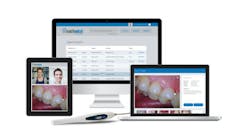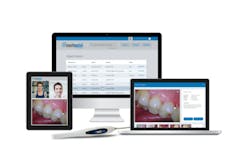Intraoral cameras and teledentistry in alternative care settings: My unexpected experience with MouthWatch
Editor’s note: Amy Ericks, RDH, BSDH, is in the process of pursuing a career in collaborative practice outside the dental practice. You can follow her journey beginning here.
ONE BENEFIT OF THIS JOURNEY that I did not anticipate has been the amazing networking opportunities, which have been inspiring and encouraging. I have had many wonderful conversations with other professionals within my community, as well as many outside of it. When I started I may have felt like I was on my own, but I quickly recognized that it needed to be, and was, a group effort.
One amazing opportunity came before I received my board approval to proceed with my collaborative agreement. I had been busy making phone calls, writing emails, and generally making several attempts to reach out to different companies with donation requests. I was still trying to piece together my most basic equipment, instruments, paperwork, and so on. I was contacted by Brant Herman, CEO of MouthWatch LLC, who had been reading these articles and was interested in what I was trying to accomplish.
MouthWatch is a teledentistry and intraoral company that has some amazing equipment and software available. Together, Brant and I we decided these products would be very useful in this pilot program. I was very excited about the idea of having this amazing equipment and software and I was very humbled that a company like this would see and believe in what I was trying to do in a small community in South Dakota.
I’ll admit, an intraoral camera was on my list of items needed, but after looking into the cost of the cameras, the need for a computer or tablet, and the associated software, it got moved to the wish list pretty quickly. I am certain that teledentistry is going to be used much more in the future of dentistry—with so many applications, how could it not? In my situation, I will be using it in my long-term care facility. I can see it also being used in schools, physicians’ offices, hospital settings, home settings, rural communities, anywhere there is an access-to-care issue!
The features of MouthWatch are well-thought-out, however, as with anything there are a few small details that need ironed out. Familiarity of the software on my part plays a big role. The more I will be able to use it and the more comfortable I get with it, the easier it is to use and the more I like it. I have found that some of those initial issues are simply due to inexperience. My tech savvy is currently adequate for navigating my email accounts and some forms of social media. I fall short when it comes to changing settings within software in order to make things work the way I want them to, but I’m learning! Brant has been great about answering my questions and helping me get things set up so that I can use the camera and software with ease.
MouthWatch intraoral camera and software platofrm options
My initial MouthWatch setup is a tablet, an intraoral camera, protective disposable sheaths, instructions for how to install the TeleDent software, and technical support (thank goodness!). The functionality of the tablet is great; the size is perfect for transporting between the facility and home or the office, and the keyboard is detachable. The program is easy to navigate, and becomes much more familiar each time that I use it.
I am impressed by the quality of the photos that I can capture with this camera, which I was nervous about initially. I have had experiences with different brands of intraoral cameras in the past; some worked great and some did not. There always seemed to two options: the cameras took poor images but were easy to use, or vice versa. The MouthWatch intraoral camera has been both easy to use and produces great images, and considering the cost of some of those other intraoral cameras I’ve used, the MouthWatch camera has a much better price point, which makes it even more appealing when looking at the overall cost that can go into putting together a pilot program like this. Affordable, beneficial, and functional! Another great feature of the software is that it is compatible with many popular dental programs.
I am so excited about what this type of equipment and software means to my collaborative agreement and how I can better serve my patients because of it. I can’t wait to describe my first experience using this in the facility. Just the idea of being able to visually document the oral conditions of these residents initially and then continually as I see them throughout the year is exciting. If this sounds like something that you have been considering for your alternative practice setting, please pursue it. Now is the perfect time to move forward, as 2018 comes nearer and the new CDT teledentistry codes can begin to be used.
Thank you all for following me on this amazing journey, it has been wonderful and inspiring with all of the progress that is being made in this area. It has also been a bit disheartening and frustrating as I see the lack of access to care and as I experience the road blocks that I have run into along the way. I welcome you to contact me with any questions, suggestions, ideas, or thoughts at [email protected].
Editor's note: This article first appeared in RDH eVillage. Click here to subscribe.
For the most current dental headlines, click here.
About the Author

Amy Ericks, BSDH, RDH
After 6 years of full-time clinical practice, Amy Ericks, BSDH, RDH, decided to pursue a journey to bring dental hygiene services to a long-term care facility. This often-neglected population has been on her mind for some time, and she is humbled to be able to be making a difference in their care. Here she walks us through her journey as she navigates this exciting new career path, stumbling blocks and all. She is also currently the president-elect of the South Dakota Dental Hygiene Association and is hopeful and encouraged about the impact she may have within her state.


